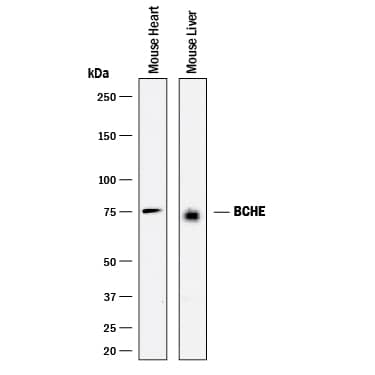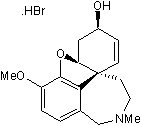Butyrylcholinesterase/BCHE Products
Butyrylcholinesterase (BCHE) is a major acetylcholine hydrolyzing enzyme in the circulation. Although it is present in significant amounts (~3 mg/L) in human plasma, no endogenous physiological substrate has been described for this enzyme. It can degrade a large number of ester-containing compounds in addition to acylcholines. Thus, it is likely to play significant pharmacological and toxicological roles. It is thought to be involved in the pathological process of Alzheimer's disease (AD) by depleting acetylcholine. In contrast to ACHE, it attenuates amyloid fibril formation in vitro. BCHE inhibitors have been used to delay symptoms of AD patients by virtue of their ability to enhance acetylcholine availability. Its involvement in a cholinergic anti-inflammatory pathway connect BCHE and ACHE with a possible marker of low-grade systemic inflammation observed in Type-2 diabetes, obesity, hypertension, coronary heart disease, and AD. BCHE can exist in monomeric and multimeric forms. The expressed recombinant mouse BCHE contains multiple forms that consist of soluble monomers, dimers, and tetramers.
75 results for "Butyrylcholinesterase/BCHE" in Products
75 results for "Butyrylcholinesterase/BCHE" in Products
Butyrylcholinesterase/BCHE Products
Butyrylcholinesterase (BCHE) is a major acetylcholine hydrolyzing enzyme in the circulation. Although it is present in significant amounts (~3 mg/L) in human plasma, no endogenous physiological substrate has been described for this enzyme. It can degrade a large number of ester-containing compounds in addition to acylcholines. Thus, it is likely to play significant pharmacological and toxicological roles. It is thought to be involved in the pathological process of Alzheimer's disease (AD) by depleting acetylcholine. In contrast to ACHE, it attenuates amyloid fibril formation in vitro. BCHE inhibitors have been used to delay symptoms of AD patients by virtue of their ability to enhance acetylcholine availability. Its involvement in a cholinergic anti-inflammatory pathway connect BCHE and ACHE with a possible marker of low-grade systemic inflammation observed in Type-2 diabetes, obesity, hypertension, coronary heart disease, and AD. BCHE can exist in monomeric and multimeric forms. The expressed recombinant mouse BCHE contains multiple forms that consist of soluble monomers, dimers, and tetramers.
| Sensitivity: | 0.06 ng/mL |
| Applications: | ELISA |
| Assay Range: | 0.156 - 10 ng/mL (Cell Culture Supernates, Cell Lysates, Tissue Lysates, Serum, EDTA Plasma, Heparin Plasma, Saliva, Urine, Human Milk) |
| Source: | CHO |
| Accession #: | P06276 |
| Applications: | EnzAct |
| Reactivity: | Mouse, Rat |
| Details: | Goat IgG Polyclonal |
| Applications: | WB, IHC |
| Source: | NS0 |
| Accession #: | AAH99977 |
| Applications: | EnzAct |
| Reactivity: | Human, Mouse |
| Details: | Rabbit IgG Polyclonal |
| Applications: | IHC, WB |
| Reactivity: | Human, Canine |
| Details: | Mouse IgG1 Monoclonal Clone #OTI1E1 |
| Applications: | WB, Flow |
| Reactivity: | Human |
| Details: | Rabbit IgG Polyclonal |
| Applications: | IHC, WB |
Recombinant monoclonal antibody expressed in HEK293F cells
| Reactivity: | Human |
| Details: | Rabbit IgG Monoclonal Clone #1E9 |
| Applications: | WB, ELISA |
Recombinant Monoclonal Antibody
| Reactivity: | Human |
| Details: | Rabbit IgG Monoclonal Clone #4N2N9 |
| Applications: | WB |
| Reactivity: | Mouse |
| Details: | Rabbit IgG Polyclonal |
| Applications: | IHC, ELISA |
| Applications: | AC |
| Applications: | WB |
| Reactivity: | Mouse |
| Details: | Rabbit IgG Polyclonal |
| Applications: | ELISA |
| Reactivity: | Mouse |
| Details: | Rabbit IgG Polyclonal |
| Applications: | ELISA |
| Reactivity: | Mouse |
| Details: | Rabbit IgG Polyclonal |
| Applications: | IHC, ELISA |
| Reactivity: | Mouse |
| Details: | Rabbit IgG Polyclonal |
| Applications: | ELISA |
| Reactivity: | Mouse |
| Details: | Rabbit IgG Polyclonal |
| Applications: | ELISA |
| Reactivity: | Mouse |
| Details: | Rabbit IgG Polyclonal |
| Applications: | ELISA |
| Reactivity: | Mouse |
| Details: | Rabbit IgG Polyclonal |
| Applications: | IHC, ELISA |
For use with catalog number DBCHE0
| Applications: | ELISA, Ctrl |
Dual AChE and BChE inhibitor
| Alternate Names: | ENA 713 |
| Chemical Name: | N-Ethyl-N-methylcarbamic acid 3-[(1S)-1-(dimethylamino)ethyl]phenyl ester (2R,3R)-2,3-dihydroxybutanedioate |
| Purity: | ≥99% (HPLC) |
Cholinesterase inhibitor
| Chemical Name: | (3aS)-cis-1,2,3,3a,8,8a-Hexahydro-1,3a,8-trimethylpyrrolo[2,3-b]indol-5-ol methylcarbamate hemisulfate |
| Purity: | ≥98% (HPLC) |
Cholinesterase inhibitor
| Chemical Name: | 4a,5,9,10,11,12-Hexahydro-3-methoxy-11-methyl-6H-benzofuro[3a,3,2-ef][2]benzazepin-6-ol hydrobromide |
| Purity: | ≥98% (HPLC) |
| Reactivity: | Mouse |
| Details: | Rabbit IgG Polyclonal |
| Applications: | ELISA |
| Reactivity: | Mouse |
| Details: | Rabbit IgG Polyclonal |
| Applications: | IHC, ELISA |





![Immunohistochemistry-Paraffin: Butyrylcholinesterase/BCHE Antibody [NBP1-85633] Immunohistochemistry-Paraffin: Butyrylcholinesterase/BCHE Antibody [NBP1-85633]](https://resources.bio-techne.com/images/products/Butyrylcholinesterase-BCHE-Antibody-Immunohistochemistry-Paraffin-NBP1-85633-img0004.jpg)
![Western Blot: Butyrylcholinesterase/BCHE Antibody (OTI1E1) [NBP2-03523] Western Blot: Butyrylcholinesterase/BCHE Antibody (OTI1E1) [NBP2-03523]](https://resources.bio-techne.com/images/products/Butyrylcholinesterase-Antibody-1E1-Western-Blot-NBP2-03523-img0003.jpg)
![Western Blot: Butyrylcholinesterase/BCHE Antibody [NBP1-69541] Western Blot: Butyrylcholinesterase/BCHE Antibody [NBP1-69541]](https://resources.bio-techne.com/images/products/Butyrylcholinesterase-BCHE-Antibody-Western-Blot-NBP1-69541-img0003.jpg)
![Western Blot: Butyrylcholinesterase/BCHE Antibody (1E9) [NBP3-15164] Western Blot: Butyrylcholinesterase/BCHE Antibody (1E9) [NBP3-15164]](https://resources.bio-techne.com/images/products/Butyrylcholinesterase-BCHE-Antibody-1E9-Western-Blot-NBP3-15164-img0001.jpg)
![Western Blot: Butyrylcholinesterase/BCHE Antibody (4N2N9) [NBP3-16712] Western Blot: Butyrylcholinesterase/BCHE Antibody (4N2N9) [NBP3-16712]](https://resources.bio-techne.com/images/products/Butyrylcholinesterase-BCHE-Antibody-4N2N9-Western-Blot-NBP3-16712-img0001.jpg)
![Immunohistochemistry-Paraffin: Butyrylcholinesterase/BCHE Antibody [NBP2-98275] Immunohistochemistry-Paraffin: Butyrylcholinesterase/BCHE Antibody [NBP2-98275]](https://resources.bio-techne.com/images/products/Butyrylcholinesterase-BCHE-Antibody-Immunohistochemistry-Paraffin-NBP2-98275-img0002.jpg)
![Western Blot: Butyrylcholinesterase/BCHE Overexpression Lysate [NBL1-07942] Western Blot: Butyrylcholinesterase/BCHE Overexpression Lysate [NBL1-07942]](https://resources.bio-techne.com/images/products/Butyrylcholinesterase-Overexpression-Lysate-Adult-Normal-Western-Blot-NBL1-07942-img0002.jpg)




